Conway Stewart No. 22 Floral 1955-56
by Jim Mamoulides, July 21, 2023
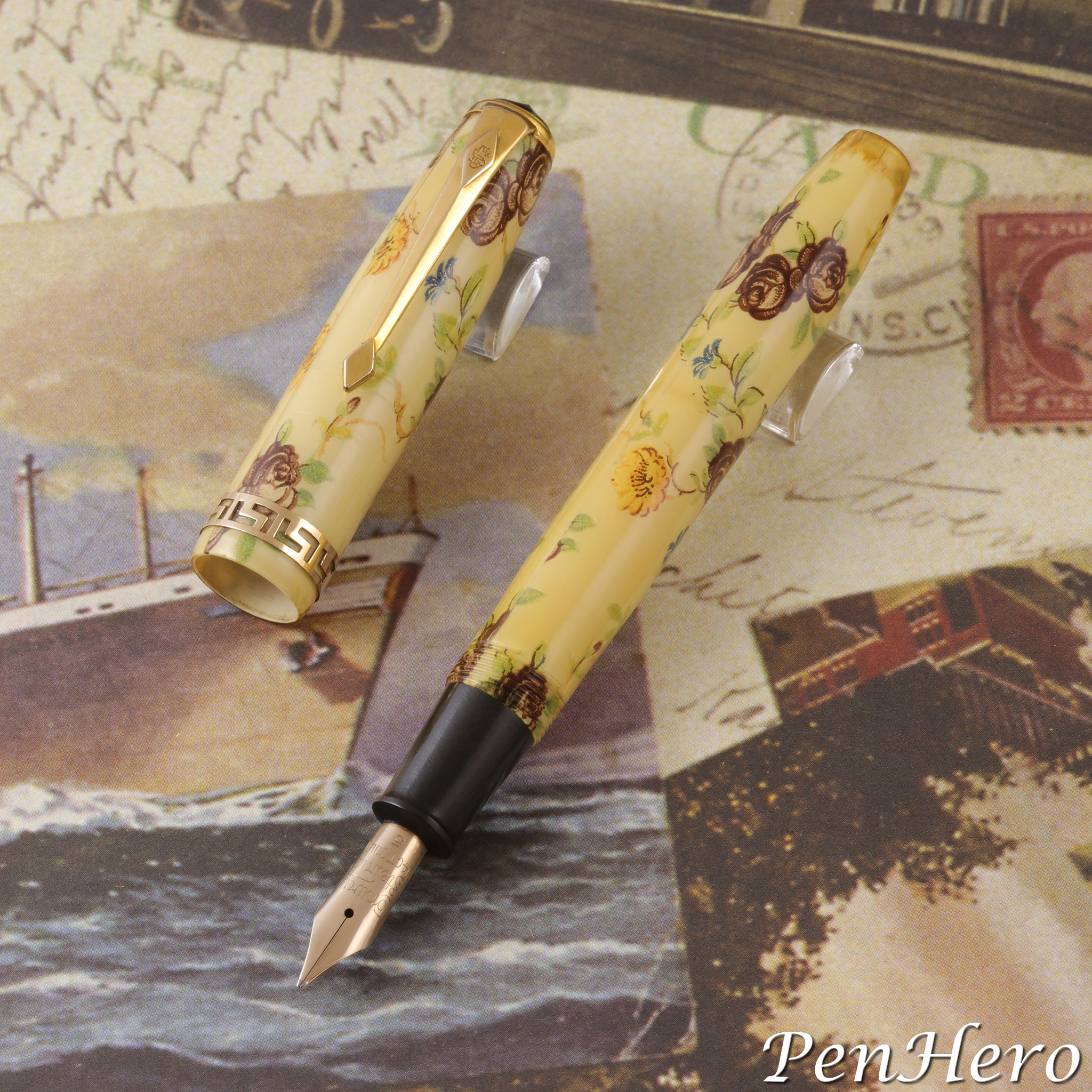 Conway Stewart No. 22 Floral 1955-56
Conway Stewart No. 22 Floral 1955-56
Fit For A Golden Jubilee
The Conway Stewart No. 22 Floral lever fill fountain pen is one of those pens that appears on many collectors “most wanted” list. Steve Hull notes in his book Fountain Pens for the Million, The History of Conway Stewart 1905-2005 that the pen was released to coincide with the company’s 1955 Golden Jubilee, having been founded fifty years earlier in 1905.
The No. 22 Floral is noted for the design on the cap and barrel, decorated with red roses, yellow and blue flowers on an ivory colored background. It’s just over 4 3/4 inches long and has a pointed black cap top jewel and gold filled trim. The washer type clip has the Conway Stewart logo stamped at the top face and a diamond shaped tip. The cap band has a cut out pattern similar to a Greek Key design. The lever tab is stamped with the Conway Stewart logo inside a diamond. The barrel is stamped Conway Stewart 22 over MADE IN ENGLAND. The 14 karat gold nib is stamped Conway over Stewart over 14CT GOLD over 5.
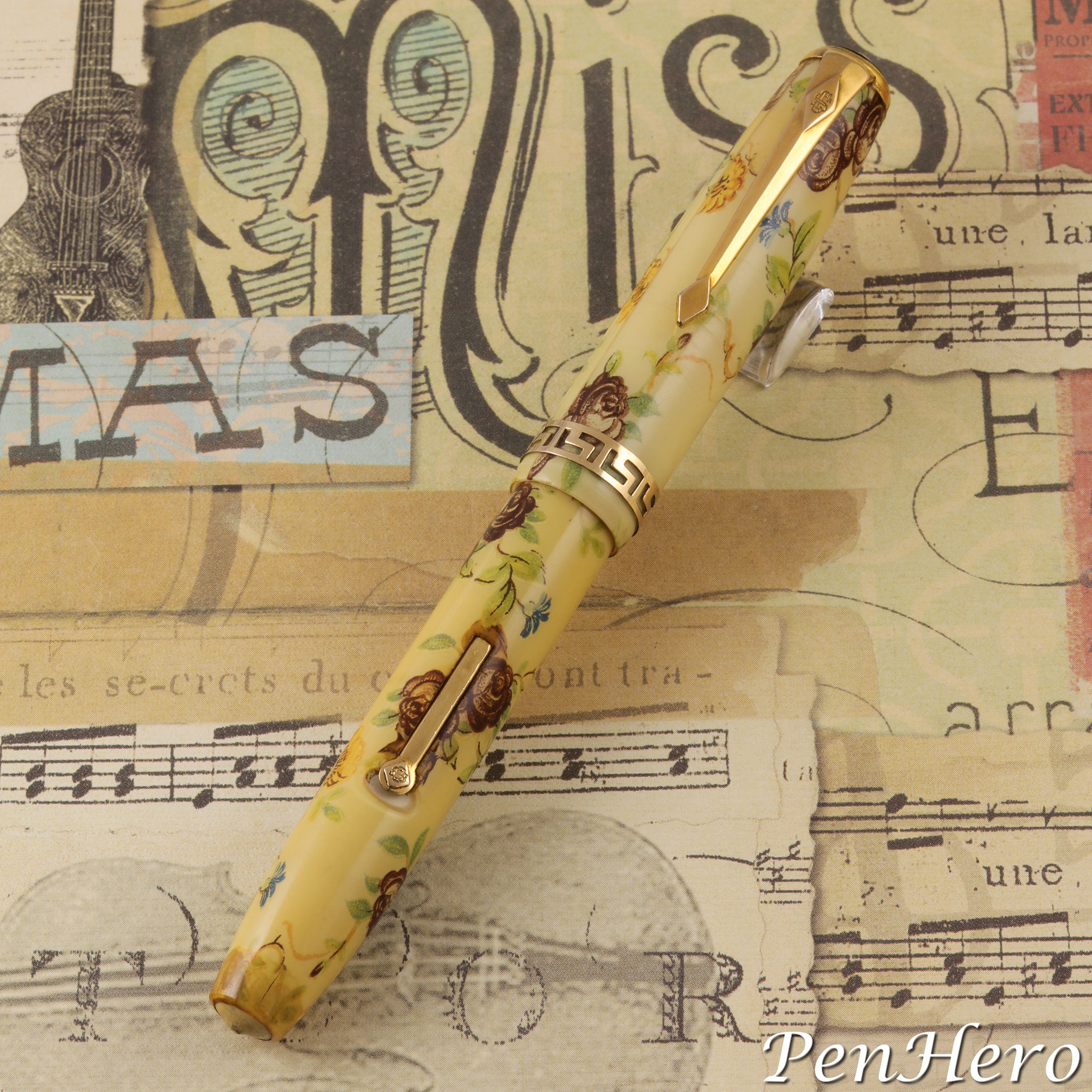 Conway Stewart No. 22 Floral 1955-56
Conway Stewart No. 22 Floral 1955-56
The No. 22 Floral first appears in the October 1955 Conway Stewart price list for 32/- and again in 1956 price lists for 32/6. It does not appear in the August 1957 price list.
When I started gathering information on this particular Conway Stewart model, I was surprised to find a history of debate on how many were made, what is the composition of the cap and barrel material, and what causes the cap and barrel discoloration seen on many examples of these pens. I don’t have primary information such as catalogs, price lists, advertisements or first-hand interviews. What I did have was the work of other collectors who do have much of that information, so this article will be a compilation of what I have discovered.
The Floral Material
What makes these pens special and desirable is of course the floral decoration. Steve Hull’s account in Fountain Pens for the Million on page 172 states,
The material from which the 22 Floral was made consisted of a laminate of a printed layer (substrate unknown, but probably some kind of paper) within protective layers of clear celluloid film.
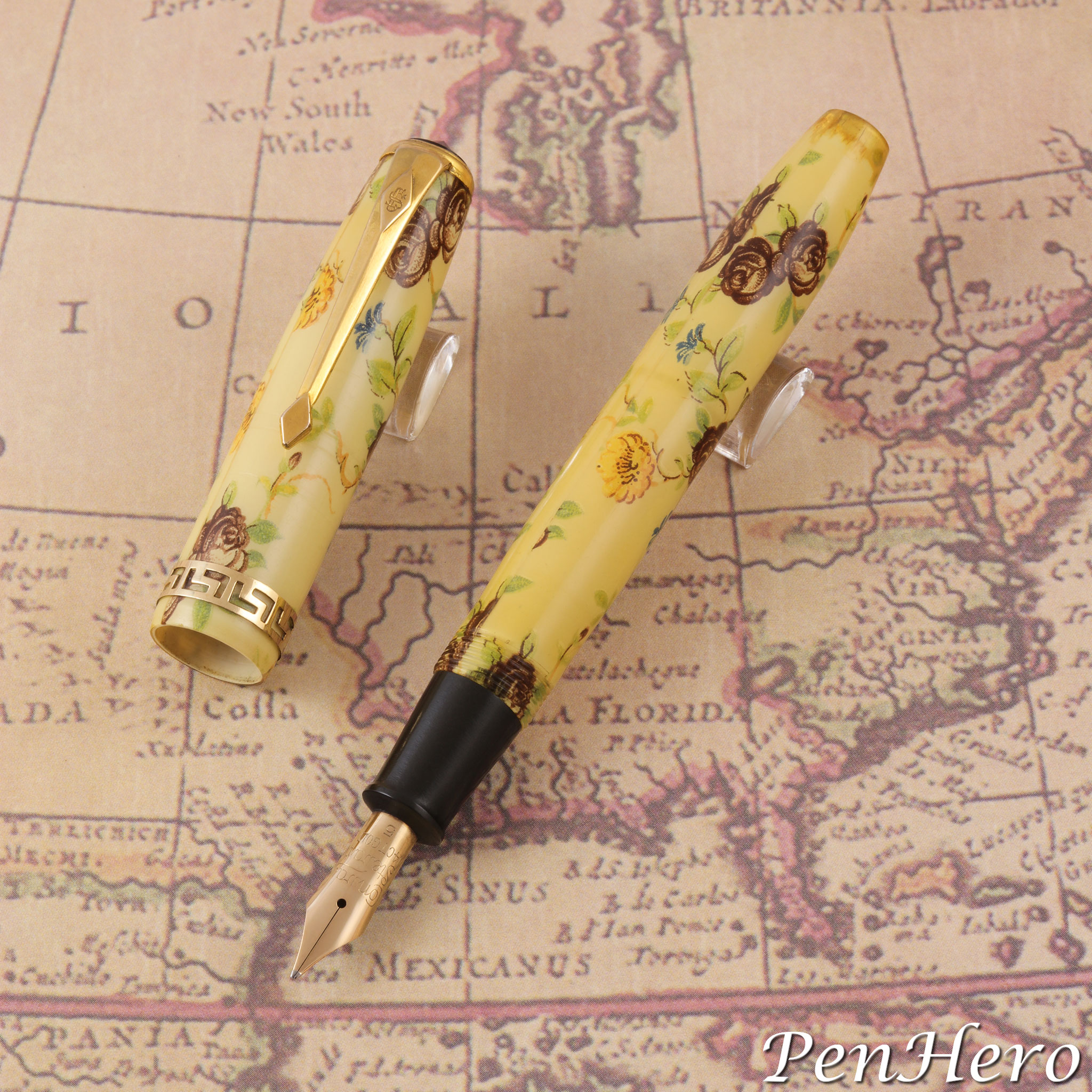 Conway Stewart No. 22 Floral 1955-56
Conway Stewart No. 22 Floral 1955-56
According to a post June 4, 2013 by Andy Russell on FPnuts.com,
The material is a paper substrate sandwiched between two clear layers of celluloid. Sulphurous vapours from the ink penetrate the first layer of celluloid but don't then escape freely to air, they are slowed down by the second layer of celluloid. Thus they get concentrated in the paper and rapidly cause serious yellowing of that layer. Other vintage materials could be similarly discoloured, see aschup's recent thread mentioning pearl & black Duofolds, but the CS floral is probably one of the last (and worst) examples of this. According to the CS production director of the time, there was no hint of these problems at the time of manufacture, but for whatever reason, they weren't able to buy further batches of the material after the first manufacturing run. Jonathan Donahaye recorded at least one other (obscure) make of pen made in the same material.
Steve Hull notes in his book Fountain Pens for the Million, The History of Conway Stewart 1905-2005 that “the deterioration (is) caused by sulphurous vapours emanating from the sac and ink.” Sulfur is one of the elements used in making rubber. It's not known exactly what the chemical process is, but the presence of ink in the rubber sac appears to activate the sulfur vapor which escapes and initiates and accelerates discoloration of the celluloid.
Examining the pen and reviewing the material description above leads me to believe the material for cap and barrel was manufactured as flat sheets that were then rolled into tubes with the seam fused. This was a common practice with celluloid pens made in the 1930s, some having straight seams down the length of the cap and barrel, and some made as spirals. The seam on this pen, a tell for this type of manufacturing, can be easily seen. The cap top hole is finished with a washer clip and a black top jewel. The barrel end is tapered to a small hole that appears to be filled with an ivory colored plug. The tapering of the ends may have been done with heat and pressure, similar to the heat molding process used on earlier celluloid pens.
Some collectors speculate the cap and barrel material was sourced from Japan where Steve Hull and some others propose Germany. There is an unauthenticated story that the same material, made in Japan, was obtained by a collector in the United States many years ago. Since I could not find any primary information that confirms where it came from, that question appears to remain an unsolved mystery.
How Many Were Made?
I remember when I bought a copy of the 1995 book Fountain Pens of the World by Andreas Lambrou. Like many others it became a wish book for many of the pens I hoped to see and possibly collect. The No. 22 Floral is mentioned on page 182,
In 1955 an unusual pen, No. 22 Floral, was offered with a design of roses and other flowers on cap and barrel; the background plastic colour was creamy white. Despite its striking appearance the model was not popular and was made only in limited numbers. It is today sought by many collectors.
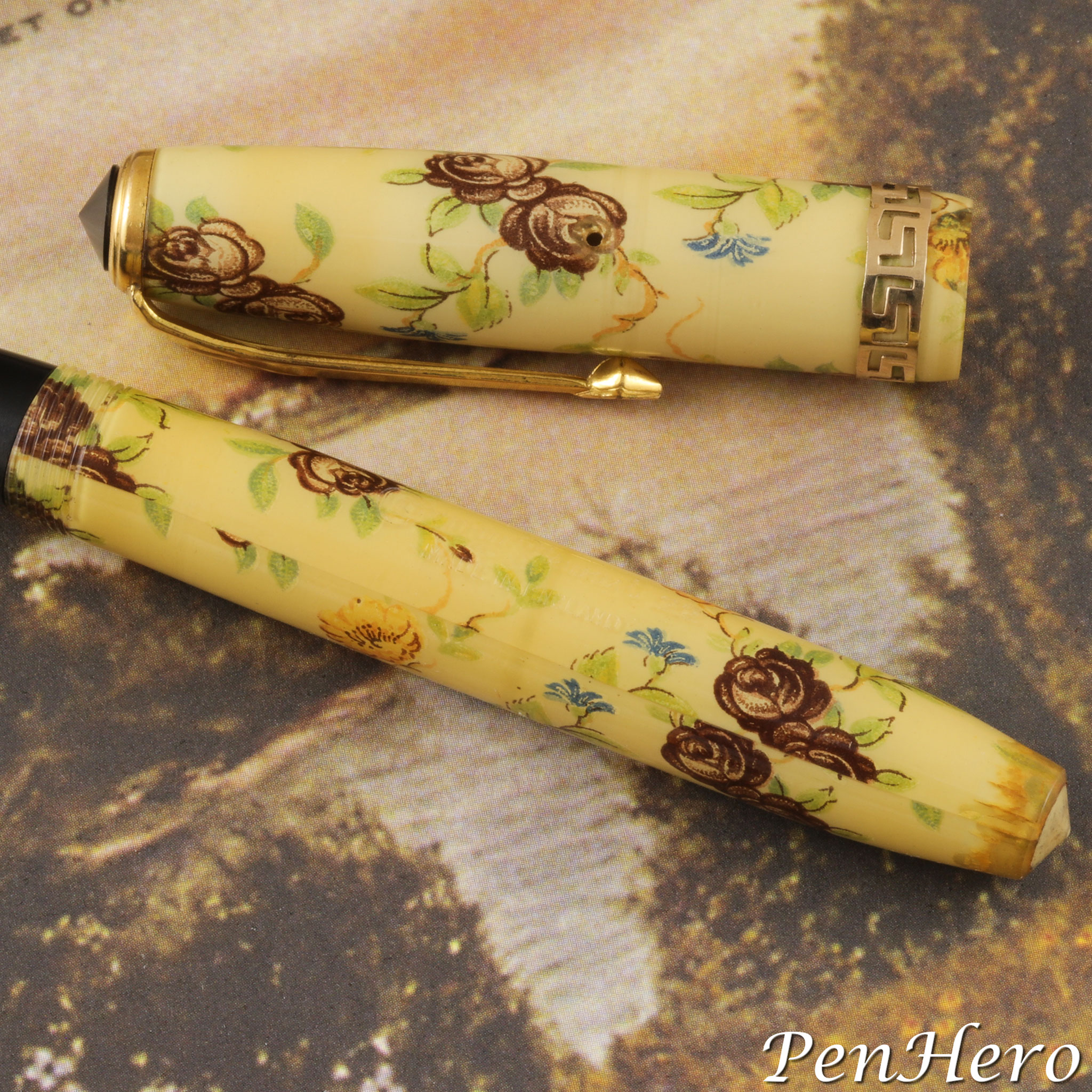 Conway Stewart No. 22 Floral 1955-56 - Imprint - crisp and deep but very faint
Conway Stewart No. 22 Floral 1955-56 - Imprint - crisp and deep but very faint
Following on page 185 is a photo of the pen amongst many other 1950s Conway Stewarts. On the facing page, 184, there is a drawing of the pen and the caption, “22 ‘Floral’, c. 1955. Very rare; it is believed 200 were made.” The cap band is described as “Greek fretwork.” The pen in the photograph is a fine example with no visible flaws.
The idea that only 200 or so of these pens were made apparently set off a lively discussion in the pen world in the late 1990s.
In a one page article in the July 1999 WES Journal Henry Simpole recounts a story where an appearance by him in the mid 1990s on a TV program prompted a letter from a lady whose husband, John Fry, worked at Conway Stewart when the Floral Pattern No. 22 was made. When asked, Fry remembered the pen and said, “we only made one ‘run’ and they were quite popular. We had quite a few requests for repeat orders, but the suppliers of the plastic had stopped producing it.” Fry then described a single production run to range between about “1,700 or 1,800, to the maximum of 2,200 finished pens.”
As if in response to questions from collectors and possibly Henry Simpole’s short article, Andreas Lambrou updated the passage on the No. 22 Floral in the Conway Stewart history chapter in his 2000 book Fountain Pens United States and United Kingdom on pages 199-200,
Some controversy exists amongst collectors as to how many Floral pens were produced. It is almost certain that the normal production batch size was around 2,000 pens and the Floral was only produced once. But there is no proof that it was a full production run. The author obtained the figure of 200 pens from an ex-Conway Stewart employee, who was responsible for marketing the Floral pen at the time. Furthermore, Bonhams of London, who carry out about six pen auctions per year, have sold around 30 Floral pens in the last ten years (since they started pen auctions) and some of these pens appeared (were recycled) more than once at auction during the ten year period. It is therefore safe, at this stage, to assume that only 200 Floral pens were ever produced.
What’s the real answer? First, I want to rely on primary source information. Henry Simpole spoke to a specific named source with first-hand knowledge. Andreas Lambrou’s source for the 200 is not named. Steve Hull identifies Bertie Woodin, a former Conway Stewart sales manager as the source of the 200 number, and that Woodin was in error, from a talk Woodin gave in 1981 to the Writing Equipment Society. Andy Russell also adds in a post on The Fountain Pen Board in 2010, “Steve's very plausible theory is that the quantity manufactured was originally stated to be 200 dozen (CS always worked in terms of dozens and gross) but as the story was retold or due to an initial mishearing, the 'dozen' became lost.” The quantity sold by Bonhams says more about the difficulty of finding auction worthy examples than how many were made or still exist.
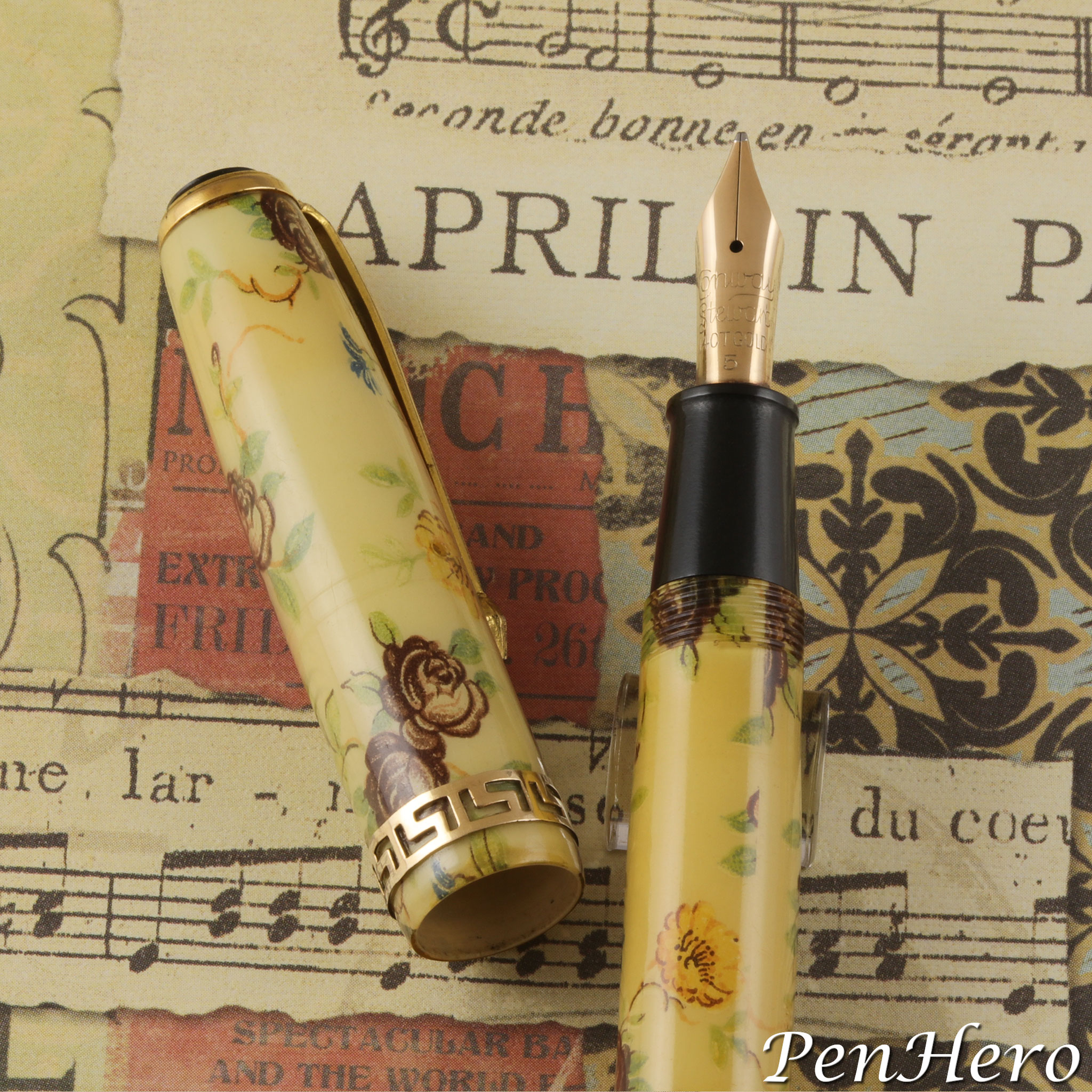 Conway Stewart No. 22 Floral 1955-56 - Nib detail
Conway Stewart No. 22 Floral 1955-56 - Nib detail
Another interesting difference in the Simpole and Lambrou accounts is that Simpole’s eyewitness John Fry says the Floral pens were “quite popular” and there were “quite a few requests for repeat orders.” Lambrou’s account in both Fountain Pens of the World and Fountain Pens United States and United Kingdom says, “the model was not popular and was made only in limited numbers.”
To me, Simpole’s article, with a named witness, and Steve Hull’s research using primary information directly address the questions raised. They are: How many No. 22 Floral pens were made? There was one production run in the 1,700 to 2,200 range, and possibly higher. Second, why weren’t more made? Conway Stewart could not get more of the special material. And third, how popular were they? Very popular to the point that dealers wanted to place repeat orders that Conway Stewart could not fill.
How Rare Is The No. 22 Floral?
As to rarity, I’m going to first approach this from the point of view of “can I get one?” No one really knows how many are in existance. Setting aside common defects such as plating loss, physical damage, and nib quality and also skipping pens in the box, with papers and with paper price bands leaves two questions. First, are they easily obtained in any condition? In my experience, one or two would be available for sale at several pen shows I’ve attended in the USA. I’ve also noticed one or two will appear for sale with some regularity on eBay. Conway Stewart specialist dealers, mostly in the UK, will sometimes have one for sale. Are there no more than thirty to fifty pens being recycled in the pen community? Who knows? If you really want a Conway Stewart Floral Pattern No. 22, you can probably get one if you are patient and don’t care about condition. I would say if condition is not a factor a No. 22 Floral would be very uncommon but not impossible to find.
Second, and the real rarity factor, concerns the condition of the cap and barrel. I personally have observed three broad condition states. First, many of the pens I’ve seen have serious discoloration of the celluloid in wide bands on the cap and barrel. More difficult to find would be pens, like this one, where the celluloid has only yellowed in a mostly uniform way. Many clear celluloids from the 1930s will amber or yellow with age and the celluloid of the No. 22 Floral appears to also have this trait. I waited several years before I found one in this condition at a price I wanted to pay. Last, and definitely rare would be pens that show no discoloration at all. In this case, the original ivory color is intact. There are Conway Stewart collectors who believe pens in this condition were never inked and some have observed that the original ink sac is still in place inside the pen, though it may have hardened. In each of these cases a No. 22 Floral is going to be pricy relative to other pens in the market, with the price increasing with better, less discolored examples.
Some Final Thoughts
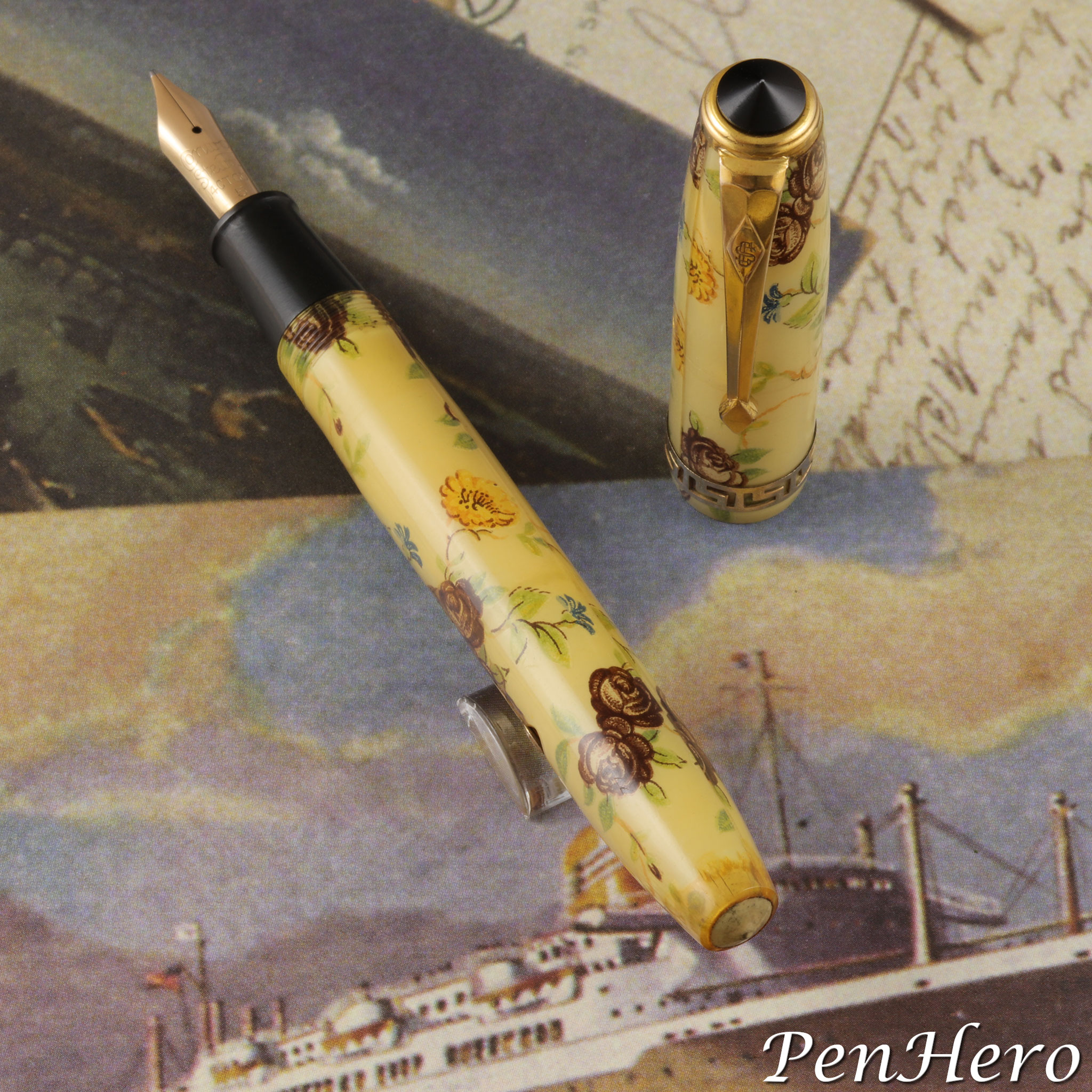 Conway Stewart No. 22 Floral 1955-56 - Note the barrel end plug
Conway Stewart No. 22 Floral 1955-56 - Note the barrel end plug
Looking at the information I collected in drafting this article brings a few things to mind. First, it is important to put dates on a pen to establish its place in time, but what dates? Should it be when the pen was manufactured? Should it include the time it was offered for sale? Should it include time the pen was in manufacturer closeout and still available? A pen model showing in a catalog or company advertisements over a period of time may actually be out of production with no plans for another run even though it’s being sold as new stock at full price. Pen retailers are familiar with this. Sometimes manufacturers say up front that the line is a limited run and other times a line is offered at closeout. A case could be made that the No. 22 Floral, with one production run in 1955, should be dated simply 1955. Another case could be made that they were catalogued in both 1955 and 1956, so they should have a date range. I’m going to go with catalog dates in this case.
The No. 22 Floral highlights the need to care for fragile pens. I don’t recommend inking one of these as there is the risk of discoloring the cap and barrel. The No. 22 Floral is a pretty, fun to own pen, but I don’t advise using them. As such, there won’t be a Performance section in this article for obvious reasons. If you find one, enjoy it for what it is. A pretty and difficult to find pen that will be a showpiece in your collection.
Acknowledgement
I highly recommend Steve Hull's book Fountain Pens for the Million, The History of Conway Stewart 1905-2005. It's over 225 pages and filled with hundreds of illustrations presented in chronological order beginning at their founding in 1905 through the end in 1975 and the brand's revival in the late 1990s. It can be obtained at englishpenbooks.co.uk. Thanks also to David Nishimura for additional information, especially on why these pens discolor.
References
"A Challenge To All Conway Stewart Collectors Please Respond, Fountain pens, Pencils, Ink-pencils & Ballpens—listing of known model numbers, as at May, 1999" collated by Barry Rose, Journal of the Writing Equipment Society, Number 55, July 1999, pages 13-15
"Conway Stewart Centenary, An Informal Celebration" by Stephen Hull, Journal of the Writing Equipment Society, Number 74, Winter 2005, page 27
Conway Stewart floral 22 Thread on fountainpenboard.com
Conway Stewart Floral in.... rather nice condition Thread on fountainpenboard.com
"Conway Stewart Pens" by Jonathan Donahaye
Fountain Pens for the Million, The History of Conway Stewart 1905-2005 by Stephen Hull, 2020 Shelley and Peacock Marlow, Buckinghamshire, UK, page 172
Fountain Pens of the World by Andreas Lambrou, 1995 Zwemmer London, UK, pages 182, 184-185
Fountain Pens United States and United Kingdom by Andreas Lambrou, 2000 Classic Pens Ltd Hertfordshire, UK, page 199-200
“The Number 22 Floral Saga” by Jonathan Donahaye
Interact
Comments on this article may be sent to the author, Jim Mamoulides


